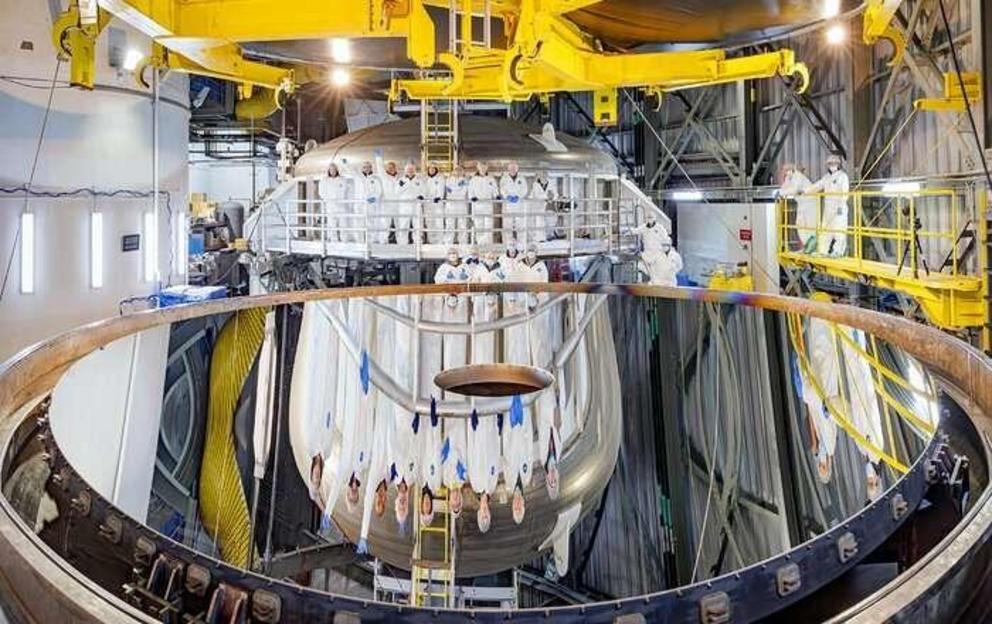Gemini North back on sky with dazzling image of supernova in the Pinwheel Galaxy
Gemini North, part of the International Gemini Observatory operated by NSF's NOIRLab, is back observing the night sky following the repair and refurbishment of its primary mirror. The telescope's debut observation captured the supernova dubbed SN 2023ixf, which was discovered on 19 May by Japanese astronomer Koichi Itagaki. This dazzling point of light, the closest supernova seen in the past five years, is located along one of the spiral arms of the Pinwheel Galaxy (Messier 101).
The Gemini North telescope, one half of the International Gemini Observatory operated by NSF's NOIRLab, has returned from a seven-month hiatus literally with a bang, as it has captured the spectacular aftermath of a supernova, a massive star that exploded in the large, face-on, spiral Pinwheel Galaxy (Messier 101). The supernova, named SN 2023ixf (lower left), was discovered on May 19 by amateur astronomer Koichi Itagaki.
Since its discovery, observers around the globe have pointed their telescopes toward Messier 101 to get a look at the burst of light. Over the coming months, Gemini North will allow astronomers to study how the light from the supernova fades and how its spectrum evolves over time, helping astronomers better understand the physics of such explosions.
The appearance of SN 2023ixf is rather serendipitous for the Gemini North telescope, which is back to observing with its primary mirror repaired and recoated after suffering damage in late 2022. The damage was limited to a small region outside of the light-collecting area of the mirror. Nevertheless, the repairs were carefully planned and completed to ensure that Gemini North could safely return to normal operations. This process lasted approximately seven months and in May 2023 the mirror was recoated and reinstalled, and the control systems were powered up and tested.
That the mirror repair was successful is evidenced in this stunning image of Messier 101 and SN 2023ixf. Not only is Gemini North a powerful discovery tool, with its 8-meter mirror and exceptional spectroscopic capabilities, but it's also located at a prime vantage point in the northern hemisphere, on Maunakea in Hawai'i, giving it an exceptional view of Messier 101.
 The NOIRLab/Gemini team pose with the newly recoated primary mirror. The damaged area can be seen to the left in the photo. It is outside the area collecting light for observations.
The NOIRLab/Gemini team pose with the newly recoated primary mirror. The damaged area can be seen to the left in the photo. It is outside the area collecting light for observations.
The Pinwheel Galaxy is located approximately 21 million light-years from Earth in the direction of the constellation Ursa Major, and is one of the most photographed galaxies in the night sky. Its face-on orientation to Earth offers a pristine view of its 170,000 light-year diameter and allows observers to marvel at its nearly one trillion stars. Speckled throughout its swirling spiral arms are large regions of star-forming nebulae, indicated by the glowing pink pockets of light. Young, hot, blue stars populate the galaxy as well, interlaced with dark dust lanes that aid in fueling the newly birthed stars.
In the image above, processed with the help of the DRAGONS software system, SN 2023ixf can be spotted in one of the galaxy's spiral arms as an exceptionally bright blue star. Follow-up observations of SN 2023ixf by both amateur and professional astronomers indicate that it is a Type II supernova. This is the closest supernova to be discovered within the last five years and the second supernova to occur in Messier 101 within the past 15 years, following a Type I supernova observed in 2011.
A Type II supernova occurs when a massive star, 8–50 times the mass of the sun, runs out of nuclear fuel, collapses in on itself, and explodes in a violent eruption of energy and matter. Typically, these events are observed in the arms of spiral galaxies where there are populations of young, massive stars, necessary for a Type II supernova to occur. During the star's collapse, the outer core caves inwards under gravity at an incredible velocity of up to 250 million kilometers per hour, or 23% of the speed of light. In a rapid ten-second burst, the explosion releases about as much energy as the sun will during its entire 10-billion-year lifetime.
Observing Type II supernovae provides astronomers insight into the evolution of massive stars and the mechanisms by which they die. And the relatively close proximity of SN 2023ixf makes the event that much more valuable to astronomers. To commemorate Gemini North's opening its eyes for the first time in seven months, SN 2023ixf makes for a truly superb target of opportunity.
The damage on the mirror edge can be seen on the far side to the left. The section is outside the area collecting light for observations.
This supernova is a prime example of the types of discoveries that will be made by Vera C. Rubin Observatory when it comes online in 2025. Rubin's powerful camera and unprecedented scanning ability will allow it to quickly detect and image supernovae and other transient events in the dynamic sky. Other powerful telescopes, like those that comprise the International Gemini Observatory, will then make follow-up observations to study the origins and evolution of these events.
"The successful repair of the Gemini North mirror was a great team effort for NOIRLab and our contractors at Safran-Reosc. Many different groups across NOIRLab worked together to resolve this difficult situation," International Gemini Observatory Director Jennifer Lotz. "Gemini/NOIRLab thanks the mirror repair team, Safran-Reosc, the independent review board, and all the staff involved in this challenging exercise."
"These new observations illustrate the amazing capabilities of the entire International Gemini Observatory and the vital role the two telescopes will play in future astronomical research," said NOIRLab Director Patrick McCarthy.
Provided by National Science Foundation

